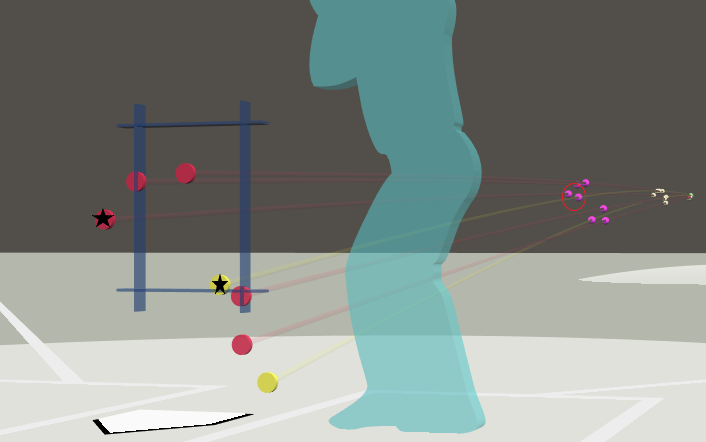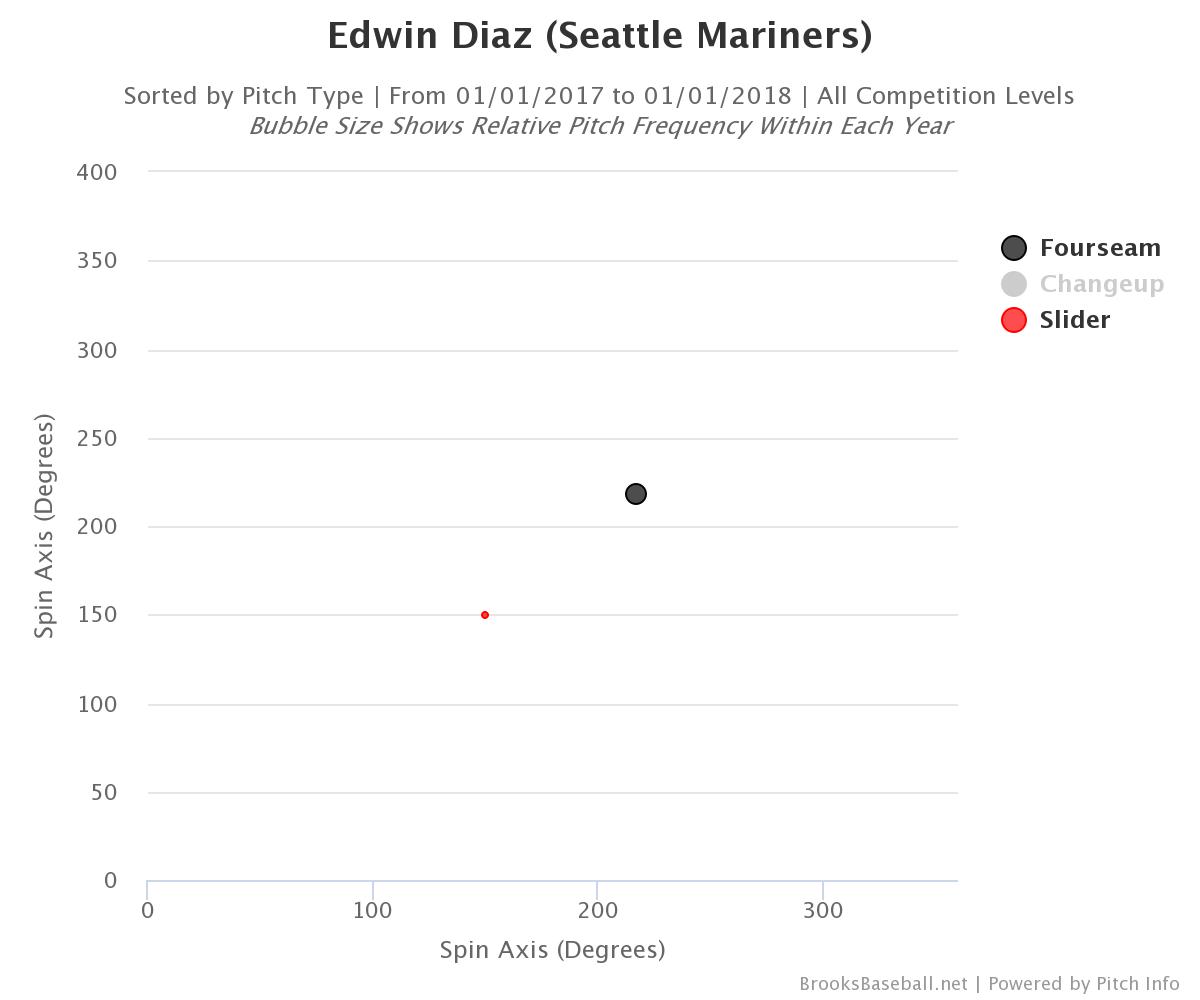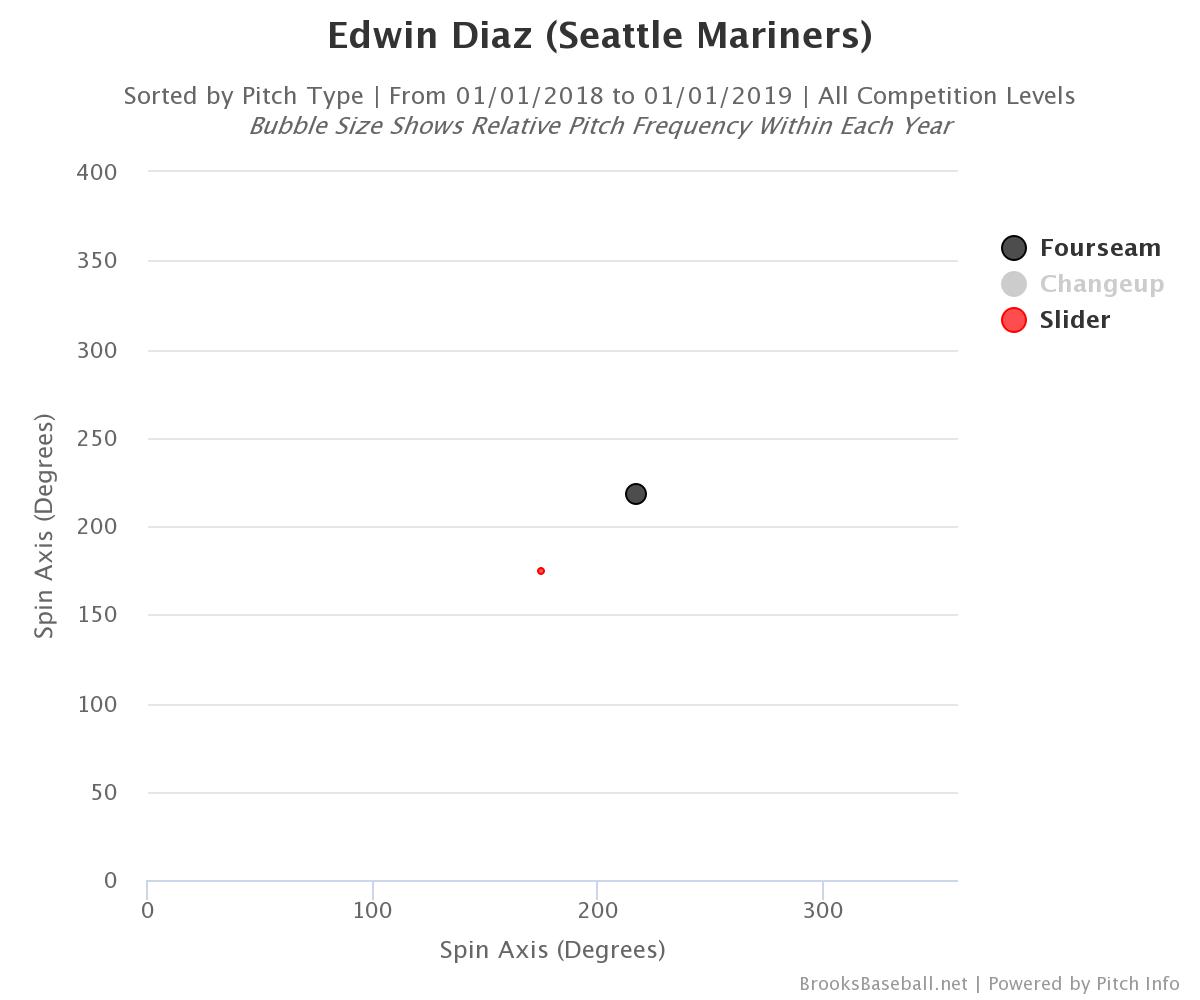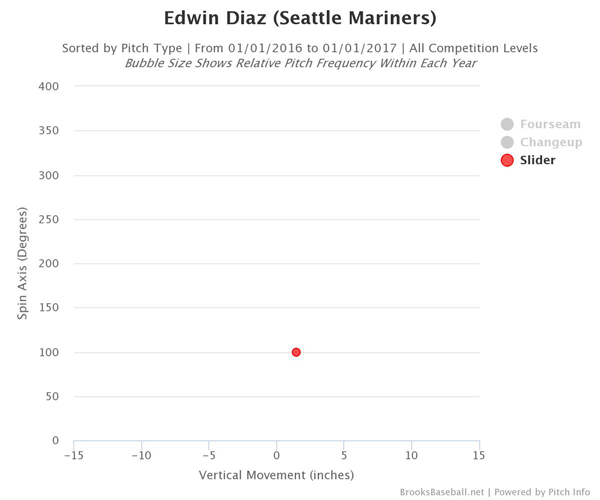(Photo by John Cordes/Icon Sportswire)
Edwin Diaz broke into Major League Baseball back in 2016 and pitched really well; 41% of hitters struck out and 7% walked for a 5.9 K/BB rate. The slider was his bread and butter, good for ninth overall in pitch value for relievers. His fastball wasn’t great but it was a good enough to set up the slider to get a strikeout. 2017, however, was a bit of a setback for Diaz. He gave up a lot of hard contact and his FB% jumped significantly, while his slider value dropped two points and his win probability added dipped despite his ability to step up in high-leverage situations.
Let’s keep in mind that Diaz didn’t have a terrible year last season. It could have been a lot worse had it not been for good defense and maybe a little bit of luck; the Seattle Mariners defense provided Diaz with a very low BABIP in 2017 despite his ERA increase of about one run. Regardless, we want to concern ourselves with how he’s making the jump to a top-tier reliever after a decent, but not great, 2017. Diaz’s wFB/100 is up 1.07 points and his slider has improved to an even 2.00, up .39 points from 2017. While his fastball helped set up that nasty slider, it’s actually the slider that’s aiding his fastball these days and is allowing Diaz to rub elbows with the elite relievers of 2018.
Several other improvements include a WHIP that has dropped from 1.15 to 0.86 and a 10% increase in K-rate to facilitate a two-point increase in K/BB ratio. His xStats show pretty even relationships; his wOBA, for example, is only .009 points different from his xwOBA. The elevated hard-hit rate mentioned earlier has dropped to 28% which is currently besting his career average of 32.8%. His groundball rate has increased by 4% and his FB% is down 6%. Both his slider and his fastball whiff rates are improved as well.
Everything about the contact Diaz yields looks better, too; both of his pitches are creating more ground balls at the expense of flyballs and his home runs on line drives and flyballs are reduced. His barrel rate and average exit velocity have remained roughly the same. His Z-Swing% is up and his chase rate remains stable while both his chase and zone contact have gone down.
As I’ve mentioned, Diaz’s opulent pitching status is the result of his slider which is actually complimenting his four-seam fastball. That seems backward since his strikeout pitch is the slider, but allow me to wallow in that ascertainment.
What stands out the most when it comes to Diaz’s one-two punch pitch selection is the break in his slider. The vertical movement on the pitch is 2.13 inches of which that break has a 1.2-inch difference from 2017.
[gfycat data_id=”everywhichequestrian”]
One inch may not seem like a lot but it’s enough to throw hitters off and the spin rate is only about 40RPMs off from his fastball. The image below shows Diaz’s pitch selection during his June 3rd outing against the Tampa Bay Rays. Diaz threw seven pitches against Brad Miller; the sixth pitch was a slider (starred, in yellow) which was fouled off, and the seventh was his fastball (starred, in red) that was hit into an out.

We know both pitches behave differently but the location difference is striking when considering the break his slider is capable of. The red circle shows the commitment point for both pitches, which is identical and the spin rate difference is just 20 RPMs. The average spin rate for a slider is about 2100RPM while a four-seam fastball is about 2230RPM. That matters because when you take the commit points for both pitches into consideration, it’s tough to discern what you’re actually getting.
Let’s stay with the spin rate for a moment. First, Diaz’s fastball spin has improved by nearly 50 RPMs on average from 2017; that increase can mean a difference in whiff rate by about 3-4%. Even his slider has seen an uptick in spin rate, enough so that the whiff rate improves (on average) from 5.4% to 7.5%. Whats more is his slider velocity has gone up 2MPH, from about 88MPH to 90MPH.
While his fastball movement has stayed about the same, the aforementioned movement on that slider is helped by a nearly half-inch horizontal release difference from 2017. The vertical release for both his fastball and slider is essentially indistinguishable but the horizontal release of both is a perfect match.
We see that his 2018 performance is somewhat mirroring his rookie year in 2016, where his benchmark for success had been established; I’ll discuss in a second. For now, lets look at the spin axis difference between last year and this year. Looking at the slider, Chart 1 (2017) and 2 (2018) show the varied spin axis between his last two seasons; no change in the four-seam fastball. Spin axis matters because it shows the adjustments made by a pitcher to create additional movement on the pitch. There is a strong correlation between the spin axis and orientation of the fingers on the ball when the pitch is released.

CHART 1

CHART 2
Now, look at how the vertical movement is effected by Diaz’s spin axis adjustments from 2016-2018.

We see varied spin each year, but similar movement in 2016 and 2018 with the latter season showing the most break (possibly) due to the change in spin axis.
All these changes/improvements have allowed Diaz to attack hitters a little differently as well. When pitching ahead or two strikes with righties, Diaz still maintains a nearly 50/50 split between his fastball and slider; lefties are seeing a 5% increase in sliders. The options Diaz has in those situations with right-handed hitters bears no adjustments, the slider effectiveness allows him to get strikeouts from either pitch keeping hitters (who expect the slider) on their toes. Even counts see lefties dealing with more fastballs while the slider usage has increased 20% when the hitter is ahead; impressive because fastballs are typically used when a batter has the edge over a pitcher who needs strikes. That alone is telling because Diaz has the utmost confidence in his slider that enables him to dial up velocity to blow the fastball by a hitter.
Diaz is one of several reasons the Mariners are currently in control of the American League West. He’s mixing his pitches well and attacking hitters in a very effective manner.

I thought Diaz was always in the elite tier of closers? Well, not the Kimbrel/Jansen tier, but the one below that. He has a history of meltdowns that still should keep him out of the potential HOF tier above him.
Only 24 years old…Saved 57 games with a team that not even made the wild card…!!! How about that!!!!